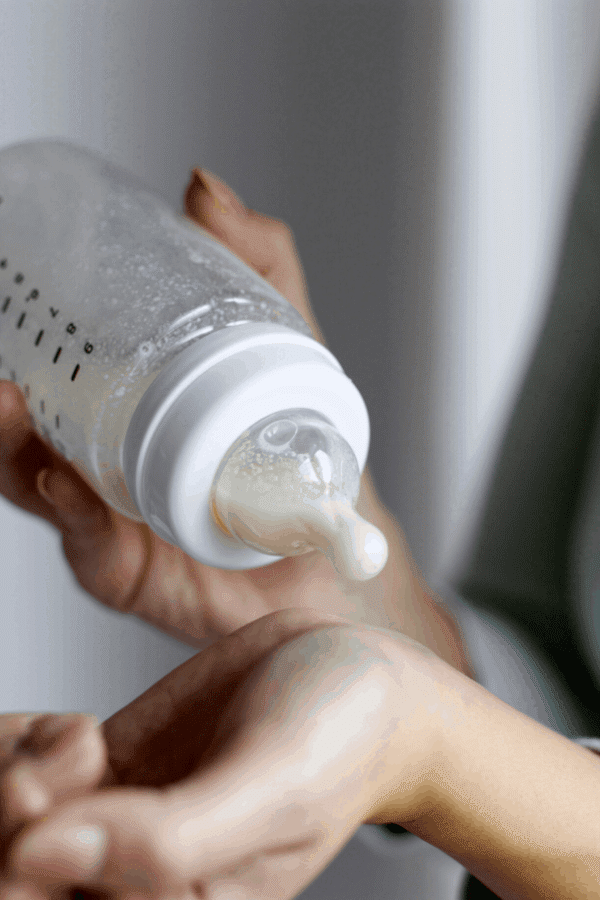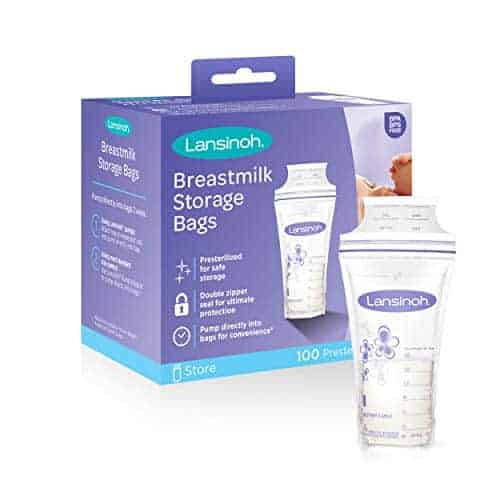Even before my first was born, I knew I wanted to breastfeed him for as long as it was possible.
Although I had my share of struggles with breastfeeding all my kids in the early days, they all turned out to be successful journeys and most importantly; happy kids.
My Biggest Fear
One of my biggest fears was returning to work.
I didn’t feel ready to stop breastfeeding. Besides, I didn’t know what I was going to do when the time arrived.
I read so much about pumping before going back to work and I found a lot of information very useful.
And so, while on maternity leave I decided to try and build up a freezer stash.
How I Went About It
During a breastfeeding class I attended, they stated that you’d only need to produce enough milk to fill one or two bottles to send to day-care.
But this was going to be my first day back at work and I needed to ensure I had more than that just in case anything happened to my supply.
It’s not an essential step but if you feel anxious it may help.
Building a freezer stash isn’t a necessity on your return to work, but I’m a worrier and I like to know things are in order if anything should go wrong.
It was a huge comfort for me knowing that we’d be prepared if there was any dip or struggle to produce.
Now, I thought I’d share some hacks of what I’ve learned.
Let me help you build the freezer stash of your dreams. I’ve also spoken to some friends who have done the same to get a better insight into different methods.
Related: Best Bassinet for Breastfeeding

As an Amazon Associate I earn from qualifying purchases. The links below may be affiliate links. Please read my disclosure policy for more information.
Tips for building a breast milk freezer stash
Two weeks before I was due to return to work, I made sure to have at least 100 ounces of milk in my freezer.
That way, any extra was always a bonus.
1. Don’t over-pump in the first 5-6 weeks
You don’t want to end up with a huge oversupply.
So, it’s best to wait until your baby is 5, 6 or even 7 weeks old.
Your supply will begin to understand demand in the early weeks, hence it’s best to wait until that supply is exactly the right amount before start pumping.
A lot of moms wait until night-time to pump if they have a decent sleeper. However, I was not one of them.
I wanted to get as much sleep as possible.
Unfortunately, early on I noticed if I didn’t pump in the early hours, I would see a dip in the amount I produced that day.
For that reason, I discovered 4 am was my golden hour, at that time I was able to produce more milk.
2. Pump during the morning nap
Once your baby goes down for their morning nap, you are given the best times to pump, especially if you have a good napper.
There’s only one problem with this schedule. It might be an inconvenience as you’re not sure how long your baby will nap for, therefore, they might wake up mid-pump or just take extra-long to go down.
My advice
When I’d put my babies down and they took a long time, I would never skip pumping that time even though I knew he wouldn’t sleep long.
I felt getting a little milk was better than none at all.

Related: 10 Reasons Exclusively Pumping Is Easier than Breastfeeding
3. If you give a bottle, leave the milk out for a while
This is only if your baby cuts their nap really short.
Now, if you’re blessed with a good sleeper, you wouldn’t need to do this.
I always had backup milk to give my babies if they decided to cut their nap short and I had pumped just minutes before.
If they napped longer, I’d simply bag it up and put it in the freezer.
Related: Storing Breast Milk (With Freezing and Thawing) in the Correct Way
Do Whatever Makes You Feel Calm
I used to do this more to calm my anxiety. The fact that I knew I had something always available, especially if they got fussy and needed more milk, made me feel more at ease.
But this also depends if your body can produce enough milk for your baby.
4. Supplements
I can’t take credit fully for being a milk making machine. Some things that helped me to increase my milk supply and ultimately helped me increase the amount I could freeze were:
5. Drink, drink, drink
To make milk you NEED to drink water. Now, I am not great at remembering to drink water, but when you are breastfeeding you will get thirsty and could end up dehydrated.
I love this bottle because it keeps my cold drinks cold for 24 hours and tea hot for 12, its perfect.
Related: How to Pump while breastfeeding
Related: Is my baby getting enough Breast Milk?
6. Taking a pumping class
There was no way I was going to be able to attend a class when I was trying to both pump and nurse. However, this online course helped.
This course gave me the confidence to pump like a pro and can be done from the comfort of your home.
There is no need to attend a class and is one of the most reasonably priced course online.
You can read my full review here.

7. Remember to label your freezer bags
To ensure you use to right frozen milk next, put the date, time and amount on each bag. This way you’ll never get mixed up and you’ll stay organized. I like to use these bags.
Related: Super Foods for your boobs: FOODS THAT WILL INCREASE BREAST MILK SUPPLY!
8. Pour the milk into a freezer bag and store
Not everyone will do it the same way, and that’s okay.
I chose to store the pumped milk as soon as it was pumped.
My only rule? It needed to be over 3 ounces.
If it wasn’t, I would put it in the fridge and mix it to make a larger bag the following day.
Some people will decide to store everything they pump in one bag, but I preferred to store either 3, 4 or 5 ounces at a time.
That way, I would have enough ounces for the day in a just couple of bags.
Related: How to Increase Breast Milk Supply in 48 hours

9. Freeze so the oldest milk stays at the front and you’re using the oldest first
If you’ve ever worked in retail, you’ll know exactly why this happens; product rotation.
None will go to waste if you make sure you keep the oldest at the front.
I used to ensure that every Monday I would use what freezer milk I had and freeze what I’d produced on Friday so the cycle was continuous and none went to waste.
Using this system ensured that I would use the older milk first.
Related: Do I have low milk supply?
10. Don’t pump extra during growth spurts
Babies tend to eat more frequently when they’re having a growth spurt.
I made the mistake with my first two kids to pump extra during the growth spurts and they were both extra fussy because when they woke up from a nap, there wasn’t enough milk.

11. Other times you can pump
A baby doesn’t follow the same schedule every single day.
It’s just not realistic!
So, I pumped at a variety of different times so my partner was able to have milk available for feedings as I wanted to ensure the baby had enough milk.
Mama of Five Recommends
• Mothers can produce more milk in less time; this breast pump was made for optimal efficiency and maximized flow
• For portable, discreet pumping
• Single knob speed/vacuum adjustments, for comfortable pump settings
• Removable cooler bag with contoured ice pack: Holds 4 breast milk bottles and ice pack to keep breast milk bottles cool
• All parts that touch breast milk are made without BPA: Safe for you and your baby
• Perfect for storing all of baby's Breast milk
• Built-in, easy-grip side handles make it convenient to pull these off the shelf
• Made of durable BPA and Chlorine free shatter-resistant plastic
• Breastmilk storage bags are ideal for storing, freezing and protecting precious breastmilk.
• Double zipper seal to prevent leakages and reinforced double sealed side seams for ultimate protection.
• Pump directly into Lansinoh breastmilk storage bags for convenience and reduced waste.
• Stand or lay flat for compact storage. Easy to use with write-on label and convenient pour spout.
When I’ve pumped and got extra milk:
• If my partner wants to give the baby’s a bottle. Whenever he decides to feed, I’ll be pumping to ensure the amount given is already replaced.
• If I ever got any plugged ducts, I would pump after my babies were unsuccessful at getting it out. You should pump and feed more to get rid of a plugged duct. Then store that milk.
• Whenever my babies slept well at night and didn’t want to be fed. In the mornings, they would usually favor one breast over the other. So, I’d pump the un-nursed breast and this way, I’d always have a lot to freeze.
• If my children didn’t empty one side, I’d use a hand pump.
Related: Hands Down The Best Online Breastfeeding Class Ever

When should I start pumping?
As I previously mentioned, you should start pumping when your baby is 5-6 weeks old.
Although this might be argued against due to the fact some moms think that breastfeeding straight away will get you used to your pump and build your milk supply up to the right amount.
Both ways are perfectly fine
I’m just mentioning what I worked better for me.
If you decide to start pumping straight away, don’t be discouraged by the output it will be low, to begin with.
You will have a suitable and high content of milk whichever way you pump, especially if you keep up a routine.
Related: 14 of the Best Breastfeeding Snacks.
What is foremilk?
Breastmilk from later in the day is richer in hindmilk and foremilk is more watery thinner milk.
This milk tends to come in the morning or after pumping sessions.
Think of it as the beverage you have with your meal.
What is hindmilk?
Hindmilk has higher fat content so you should think of this as the meat and potatoes of your meal.

Importance of hindmilk and foremilk
Foremilk separates from hindmilk when it has spent some time in the fridge.
For this reason, try to make sure you always swirl the bottles before pouring it so it mixes well.
The richer fat tends to get stuck on the sides of the bottles too, so just run warm water on the outside of the bottles and swirl again so it mixes smoothly.
Related: Everything You Need to Know About Power Pumping
Which One Is Best?
Both are important because you want a balanced meal for your baby because too much foremilk can cause a gassy baby.
This is why it’s crucial to label up your bottles.
You don’t want to end up taking a bottle from the freezer and find out it has turned completely to foremilk.
The Perfect Balance
If you mix a bag from the morning with one from the evening or night, then you’ll be creating an amazing well-balanced meal for your baby.
More tips on storing breast milk
Not only is the reason for labeling the breast milk a good indication as of which one to use next, but It’s also great for sleep-deprived moms who think to themselves:
“I’m saving the same amount every time, so what’s the need for writing it?”
As soon as you start to pump different amounts, you’ll soon understand the importance.
If you freeze smaller amounts, you’ll have less waste. So even though the bags might be able to hold 6oz, you don’t have to fill it to that amount. 4 or 5 ounces is usually perfect.
Related: There is Blood In my Breastmilk. Should I be worried?

How to store breast milk
The best way I’ve found to store breast milk in the freezer is by to lay the milk bags flat, so they freeze in a nice thin layer and then stand them up in this so you’re able to store several bags.
This way you can store the oldest milk at the front, and put the newest at the back.
I bought 4 of them to ensure that there was enough room for me to stash the amount of milk I’d be storing.
Better To Be Safe Than Sorry
If you put your mind to it and put the work in with pumping, it will pay off in the long run. You’ll reach your breastfeeding goals.
It’s never easy being away from your baby, but hopefully, these guidelines will help and ease you into it to make an amazing breast milk stash.













